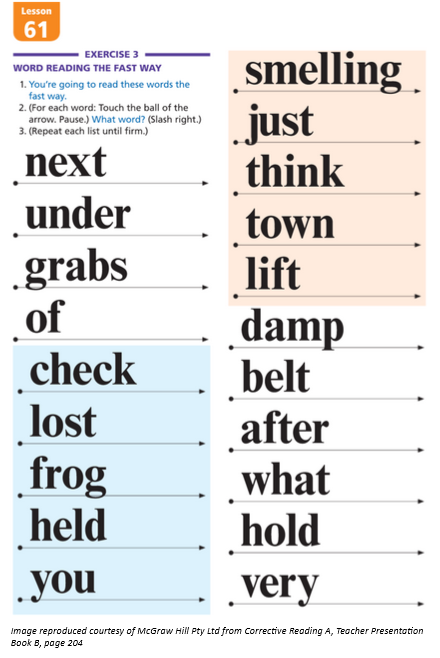Practice Use Signals
-
Module introduction2 Topics
-
Delivered With Fidelity26 Topics|2 Tests
-
Cover
-
Module Objective
-
What Happens when the Technique is Delivered with Fidelity
-
Parts of a Signal
-
Parts of a Signal Continued
-
Video: Parts of a Signal
-
Types of Signals and when they are Used
-
Video: Hand-drop Signal
-
Video: Auditory Signal
-
Video: Point-touch Signal
-
Video: Point-touch Slide Signal
-
Video: Fingers signal
-
Video: Digits Signal
-
Video: Looping Signal
-
Attention Signal
-
Using Signals Effectively
-
Allows the Teacher to Check for Mastery
-
Allows the Teacher to Check for Mastery
-
Allows Students to Actively Engage in the Lesson
-
Allows Students to Actively Engage in the Lesson
-
Video: Allows Students to Actively Engage in the Lesson
-
Provides Students with Valuable Practice
-
Provides Students with Valuable Practice
-
Check your understanding
-
Test your understanding
-
Lesson Completed
-
Cover
-
Not Delivered With Fidelity14 Topics|2 Tests
-
Cover
-
What happens when Technique is not Delivered with Fidelity
-
Not using Signals Effectively
-
Video: Not using Signals Effectively
-
Doesn’t Allow the Teacher to Check for Mastery
-
Doesn’t Allow the Teacher to Check for Mastery
-
Students do not Actively Participate in the Lesson
-
Students do not actively Participate in the Lesson
-
Video: Teacher Demonstrating Error when Signalling
-
Students do not get Adequate Practice and Confidence Drops
-
Students do not get Adequate Practice and Confidence Drops
-
Check your understanding
-
Test your understanding
-
Lesson Completed
-
Cover
-
Barriers That Impede Fidelity9 Topics|2 Tests
-
Cover
-
Barriers that Impede Delivery of the Technique with Fidelity
-
Using Deductive Logic to Identify the Cause of the Barrier
-
Not Understanding why Using Signals Effectively is Required
-
Not Understanding How to Use Signals Effectively
-
Unfamiliar with Lesson Content
-
Check your understanding
-
Test your understanding
-
Lesson Completed
-
Cover
-
Removing Barriers That Impede Fidelity12 Topics|2 Tests
-
Cover
-
Ways to Tackle Barriers so Technique is Delivered with Fidelity
-
Understand why Using Signals Effectively is Required
-
The Process
-
Learn how to Use Signals Effectively
-
The Process
-
Become Familiar with Lesson Content
-
The Process
-
Video: Practice Makes Signalling Perfect
-
Check your understanding
-
Test your understanding
-
Lesson Completed
-
Cover
-
Module evaluation survey1 Topic
Participants 521
Using Signals Effectively
ddewell@goodtogreatschools.org.au August 7, 2023

Using Signals Effectively
During a reading lesson, Kyle (teacher) is taking students through an exercise where students are asked to read the ‘fast way’. Kyle holds the teacher presentation book up so it can be clearly seen by the class. He gives the focus instruction: “You are going to read these words the ‘fast way'”, then “First word”. Kyle holds his finger about two centimetres over the ball of the arrow for the word ‘next’, pausing for one or two seconds to allow for think time. He gives the cue; “What word?” and pauses for one second before sliding his finger decisively along the arrow, then returning his finger back to the ball of the arrow. The students give the correct response, “next”. Kyle affirms his students by saying; “Yes, ‘next'”. Kyle holds his finger about two centimetres over the ball of the arrow for the word ‘under’, pausing for one or two seconds to allow for think time. He says; “What word?” and pauses for one second before sliding his finger decisively along the arrow before returning his finger back to the ball of the arrow. Students give the correct response, “under”. Kyle affirms his students by saying; “Yes, ‘under'”.
During a maths lesson, Taylor (teacher) requires students to answer as a group to identify numbers in their workbooks. She uses an ‘auditory signal’ by snapping her fingers to initiate the response. Taylor gives the instruction; “You are going to read the ‘number'”, focusing the students by saying “First number”. She then pauses for two seconds to allow for think time before giving the cue, “What number?”. She pauses for one second before snapping her fingers. Students give the correct response, “fourteen”. Taylor affirms her students by saying; “Yes, ‘fourteen'”.


